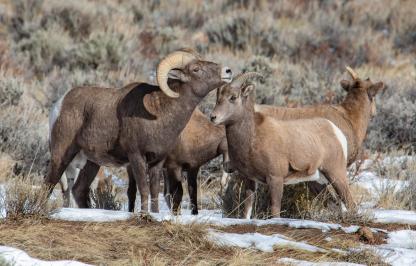Wyoming Game and Fish Department wildlife biologists and game wardens recently completed mule deer classification surveys in the Sheridan Region, which covers the majority of northeast Wyoming. These surveys take place annually to gather information on current deer numbers and are not a total count of the entire herd, but rather a sample of the population. This year, wildlife managers located and classified 9,328 mule deer, as well as 5,689 white-tailed deer.
When deer are classified, biologists and wardens identify each individual animal as an adult buck, yearling buck, doe or fawn. The results are analyzed as herd ratios, or, the number of fawns, yearling bucks and adult bucks counted for every 100 does counted. The yearling buck ratio is influenced by the previous year’s fawn production and overwinter survival into the yearling-age class. It provides wildlife managers insight into how well last year’s fawns survived their first winter.
Herd ratios allow managers to monitor trends in the proportion of fawns and bucks in a herd from year-to-year. These ratios are influenced by several factors including fawn production and recruitment, natural mortality and harvest. Information from the surveys is used by wildlife managers to update herd population estimates and set hunting seasons.
Overall, fawn ratios increased about 15 percent from 2018. This increase is attributed to improved precipitation and the extended spring green-up associated with abundant spring rains. High buck ratios were found in nearly all hunt areas indicating good numbers of mature deer after the hunting season. Conservative hunting strategies in private land hunt areas contribute to high buck ratios. The yearling buck ratio decreased due in part to the lower 2018 fawn ratio. This contributed to a lower overall 2019 buck ratio.
Buffalo and Kaycee area
This year, 3,344 mule deer were classified in Hunt Areas 26, 27, 29, 30-33, 163 and 169. Overall, the fawn ratio averaged 64 fawns per 100 does, an increase from the 58 fawns per 100 does classified in 2018. This year’s buck ratios averaged 34 bucks per 100 does, a decrease from 42 bucks per 100 does in 2018. Even though the ratio was down from last year, hunt areas continue to support high buck numbers including good numbers of mature bucks. The yearling buck ratio was eight per 100 does.
“In general, these populations are fairly stable without remarkable annual fluctuations,” said Buffalo Wildlife Biologist Cheyenne Stewart. “There are some longer-term trends in certain areas that are concerning to us, which is why we are investing so much time and energy into targeted research projects such as the Upper Powder River Mule Deer Study initiated in December 2018 and the movement study of mule deer in two herds east of Buffalo initiated in November 2019.”
Gillette and Moorcroft area
This year, 4,061 mule deer were classified in Hunt Areas 1, 3, 10, 17-19 and 21. Overall, the fawn ratio averaged 63 fawns per 100 does compared to 54 fawns per 100 does in 2018. This year’s buck ratio was 34 bucks per 100 does, down from 45 bucks per 100 does in 2018. The yearling buck ratio was eight per 100 does.
Sheridan area
This year, 1,923 mule deer were classified in Hunt Areas 23 and 24. The fawn ratio was 90 fawns per 100 does, well above the 70 fawns per 100 does observed in 2018. The 45 bucks per 100 does indicates high buck numbers and good numbers of older age class bucks in some of the Region’s best mule deer habitat. Last year’s buck ratio was 53 bucks per 100 does. The yearling buck ratio was 10 per 100 does.
White-tailed deer
White-tailed deer were also surveyed with over 5,689 classified in 14 hunt areas. The fawn ratio was 76 fawns per 100 does whereas the adult buck ratio was 24 bucks per 100 does. The yearling buck ratio was 12 yearling bucks per 100 does.
Deer Classifications
3076727418


